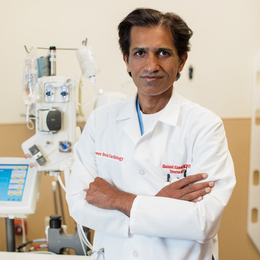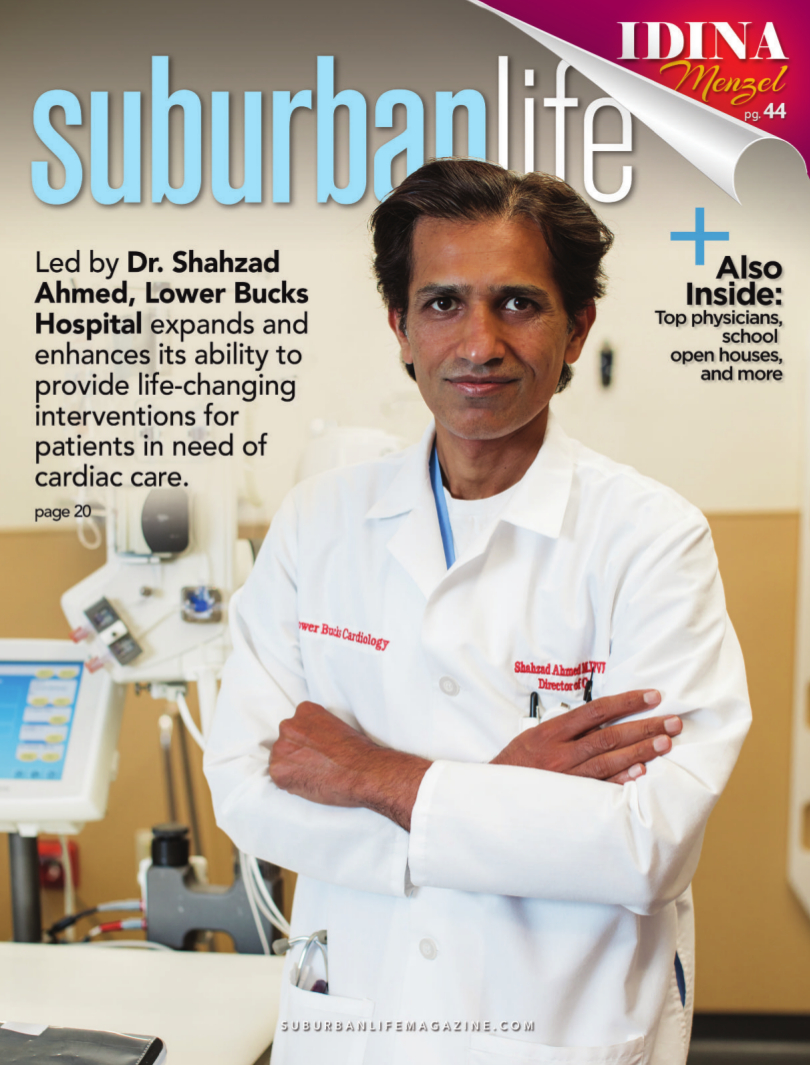
Never Missing a Beat
Led by Dr. Shahzad Ahmed, Lower Bucks Hospital expands and enhances its ability to provide life-changing interventions for patients in need of cardiac care.
Heart disease remains the No. 1 cause of death in the United States. An American will have a heart attack every 39 seconds. Cardiovascular disease claims nearly 900,000 U.S. deaths per year. Stroke is a leading cause of serious long-term disability in the United States.
These grim statistics from the American Heart Association suggest that the heart is the ultimate paradox. While it’s an incredibly strong and resilient muscle that serves as the engine for the human body, the heart is also surprisingly vulnerable, if not fragile.
Preventive measures such as moderate exercise, stress-reduction techniques, and a heart-healthy diet can reduce the risk of cardiovascular disease. Even so, medical interventions often become necessary to stave off an issue that could jeopardize a person’s life.
Shahzad Ahmed, M.D., FACC, FSCAI, stands ready to help. As the leader of interventional cardiology for Lower Bucks Hospital in Bristol, Dr. Ahmed appreciates the opportunity to help patients improve their health through a combination of coronary interventions and prescribed lifestyle changes.
Dr. Ahmed joined Lower Bucks Hospital’s BMC Cardiology Practice LLC in 2019. He was drawn to Bucks County because of the hospital’s unwavering commitment to serving the community. He also saw an opportunity to enhance and expand the hospital’s delivery of excellent cardiac care to residents of Bucks County and surrounding areas.
“In the two years since I have come here, we have experienced more than 100 percent growth in the patients we have treated and implemented a lot of new changes,” he says. “For example, the old way of cardiac catheterization was to go through the groin. We have changed the culture by accessing arteries in the hand or wrist; it’s more comfortable for the patient, and it also has a lower risk.”
Dr. Ahmed and his fellow practitioners at Lower Bucks Hospital provide the full gamut of preventive measures for heart failure, stroke, and other life-threatening cardiovascular conditions. In fact, the hospital has invested in a second cardiac catheterization lab, due to open later this year, and expanded its medical staff with the addition of a newly hired interventional cardiologist.
“I’m excited about where we go from here,” Dr. Ahmed says. “We already have the capability to help patients with all kinds of heart-related issues, including those who have comorbidities like diabetes, high blood pressure, and problems with the lower extremities. We also have a carotid program to fix arteries going to the brain to prevent stroke. The new catheterization lab will give us more flexibility to treat patients in an emergency, and it will include many new advancements in technology that will tremendously increase our capability.”
For example, an intravascular ultrasound machine will provide a highly detailed view of a patient’s coronary artery to show real-time evidence of disease. The catheter-based diagnostic procedure can essentially quantify the percentage of narrowing or thickening of the artery and enable a physician to see plaque buildup that may have been missed during an angiogram.
“For a lot of patients who experience chest pain and we don’t find blockages,” Dr. Ahmed says, “we will have pressure wire to detect blood pressure difference in smaller arteries, and to detect and treat microvascular dysfunction.”
Going Forward
Lower Bucks Hospital has received multiple honors and awards, including recognition from the American Heart Association/American Stroke Association for the quality of care delivered to stroke patients. Dr. Ahmed appreciates the hospital’s reputation as a trusted community hospital, but he says its capabilities are increasingly robust for a hospital of its size.
“It’s amazing the things we can do now, because our understanding has changed and the technology has taken great leaps forward,” he says. “Recently we had a patient in middle age, 50 to 55, who came in unresponsive with no pulse. They had been doing CPR on him for 45 minutes, and the patient’s chances of surviving were considered less than 10 percent. We used a mechanical pump to support and stabilize the patient’s heart. Within a couple of days, the patient recovered.”
Dr. Ahmed has advanced specialization in coronary interventions, peripheral arterial and venous disease, and structural heart disease. He is considered a leading expert in heart and rhythm disorders, including congestive heart failure, coronary artery disease, and vascular disease, as well as sudden death prevention and critical limb ischemia. He also specializes in nuclear stress testing, echocardiograms, and vascular imaging.
Dr. Ahmed began his medical education at Allama Iqbal Medical College in Lahore, Pakistan, and continued his training in Philadelphia through the Educational Commission for Foreign Medical Graduates. He did his internship and internal medicine residency at Drexel University at Hahnemann University Hospital. He also completed a fellowship in cardiovascular medicine and interventional cardiology through Drexel. He has since become board certified in echocardiography, vascular ultrasound, nuclear cardiology, interventional cardiology, cardiovascular medicine, and internal medicine. In addition, he is a fellow of both the American College of Cardiology and the Society for Cardiovascular Angiography and Interventions.
“I came to Lower Bucks Hospital because I saw an incredible opportunity here,” he says. “Moving forward, we have a new state-of-the-art catheterization lab, a new interventional cardiologist, and other investments the hospital has made to help sick patients in the community.”
His goal: to help Lower Bucks Hospital in its quest to become a veritable “one-stop shop” for any patient in need of first-class interventional cardiac care.
“We can treat patients across the spectrum,” he says. “We are able to take care of them, fix blockages, and improve circulation. For patients who come in with clotted veins, we can improve function and even save patients’ legs. We’re treating patients across all comorbidities, with the full scope of interventional procedures. We have an opportunity to make a big difference in people’s lives. That’s why I moved here, and I’m very glad I did.”
Lower Bucks Hospital
501 Bath Road
Bristol, PA 19007
(215) 785-5100
Photography by Gabriela Barrantes
Published (and copyrighted) in Suburban Life magazine, August 2021.



